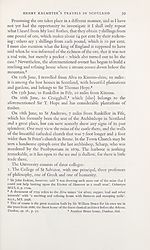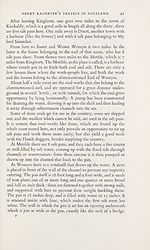Series 4 > Scottish industrial history
(85) Page 40
Download files
Complete book:
Individual page:
Thumbnail gallery: Grid view | List view

40
SCOTTISH INDUSTRIAL HISTORY
2. The College of St Mary, with one principal, one professor of
theology, one of oriental languages, one of ecclesiastical history.
3. The College of St Leonard, with one principal, three professors
of philosophy, one of Greek, one of humanity, and also one
librarian: but the library was nothing remarkable, having mainly
old books, and these in no quantity.
On 23rd June I started by return journey to Edenburg from
Rankillor, and travelled 14 miles to Brunt Island: which is a little
town just opposite Edenburg on the other side of the Fyrth of Forth.
It has a small but very good harbour, where the greatest ships can
lie. There is a mill there worth seeing, as it is worked by seawater
coming up with the tide, running into channels and then begining
the mill into operation with the falling ebb.1
One mile away on an estate called Newbiggin I visited a cave or
cavern on the beach, where petrijicata coneretiones nitro-calcaria are to
be found.2
On 24th June (Heaven be praised!) I came successfully back to
Edenburg.
On 30th July I travelled again from Edenburg over the Fyrth
of Forth at Lith to visit the saltworks on the other side. Although
such works are found on both sides of this water I cannot mention
them all, there being 85 pans in operation on the Fife side alone:3
I will therefore only discuss those at Metthle and Liven, because they
have the same character as the others, and because one may judge
the manner of making salt from their differences.
1 Tide mills were not very uncommon in England and Wales, but this appears to be
the only record of such a mill in Scotland. See Rex Wailes, ‘Tide Mills in England
and Wales’, Transactions of the Newcomen Society, xix, (1937-8), pp. 1-33.
2 ‘ Fossils of the vegetable kind are found, but not in great abundance, at the quarries
at Newbigging, and at the old sandstone quarries near the coast.’ New Statistical
Account, ix, Fife, p. 408.
3 There is a brief but useful survey of the Scottish salt industry by Ian H. Adams,
‘The Salt Industry of the Forth Basin’, Scottish Geographical Magazine, Ixxxi (1965),
pp. 153-61. Kalmeter, however, gives a picture of prosperity after the Union which
conflicts with the impression conveyed by Dr Adams. Kalmeter’s picture is confirmed
by the studies in the British salt industry by Edward Hughes, who points out that the
Forth industry was much more prosperous than that of north-east England after
the Union due to, and not in spite of, the English salt duties imposed after 1707.
For two generations after the Union, northern England was flooded with Scottish
salt which paid less than a third of the tax paid by the north-east English salters.
E. Hughes, Studies in Administration and Finance, 1558-1825 (Manchester, 1934),
pp. 4l3ff.
SCOTTISH INDUSTRIAL HISTORY
2. The College of St Mary, with one principal, one professor of
theology, one of oriental languages, one of ecclesiastical history.
3. The College of St Leonard, with one principal, three professors
of philosophy, one of Greek, one of humanity, and also one
librarian: but the library was nothing remarkable, having mainly
old books, and these in no quantity.
On 23rd June I started by return journey to Edenburg from
Rankillor, and travelled 14 miles to Brunt Island: which is a little
town just opposite Edenburg on the other side of the Fyrth of Forth.
It has a small but very good harbour, where the greatest ships can
lie. There is a mill there worth seeing, as it is worked by seawater
coming up with the tide, running into channels and then begining
the mill into operation with the falling ebb.1
One mile away on an estate called Newbiggin I visited a cave or
cavern on the beach, where petrijicata coneretiones nitro-calcaria are to
be found.2
On 24th June (Heaven be praised!) I came successfully back to
Edenburg.
On 30th July I travelled again from Edenburg over the Fyrth
of Forth at Lith to visit the saltworks on the other side. Although
such works are found on both sides of this water I cannot mention
them all, there being 85 pans in operation on the Fife side alone:3
I will therefore only discuss those at Metthle and Liven, because they
have the same character as the others, and because one may judge
the manner of making salt from their differences.
1 Tide mills were not very uncommon in England and Wales, but this appears to be
the only record of such a mill in Scotland. See Rex Wailes, ‘Tide Mills in England
and Wales’, Transactions of the Newcomen Society, xix, (1937-8), pp. 1-33.
2 ‘ Fossils of the vegetable kind are found, but not in great abundance, at the quarries
at Newbigging, and at the old sandstone quarries near the coast.’ New Statistical
Account, ix, Fife, p. 408.
3 There is a brief but useful survey of the Scottish salt industry by Ian H. Adams,
‘The Salt Industry of the Forth Basin’, Scottish Geographical Magazine, Ixxxi (1965),
pp. 153-61. Kalmeter, however, gives a picture of prosperity after the Union which
conflicts with the impression conveyed by Dr Adams. Kalmeter’s picture is confirmed
by the studies in the British salt industry by Edward Hughes, who points out that the
Forth industry was much more prosperous than that of north-east England after
the Union due to, and not in spite of, the English salt duties imposed after 1707.
For two generations after the Union, northern England was flooded with Scottish
salt which paid less than a third of the tax paid by the north-east English salters.
E. Hughes, Studies in Administration and Finance, 1558-1825 (Manchester, 1934),
pp. 4l3ff.
Set display mode to:
![]() Universal Viewer |
Universal Viewer | ![]() Mirador |
Large image | Transcription
Mirador |
Large image | Transcription
Images and transcriptions on this page, including medium image downloads, may be used under the Creative Commons Attribution 4.0 International Licence unless otherwise stated. ![]()
| Scottish History Society volumes > Series 4 > Scottish industrial history > (85) Page 40 |
|---|
| Permanent URL | https://digital.nls.uk/126656031 |
|---|
| Description | Over 180 volumes, published by the Scottish History Society, containing original sources on Scotland's history and people. With a wide range of subjects, the books collectively cover all periods from the 12th to 20th centuries, and reflect changing trends in Scottish history. Sources are accompanied by scholarly interpretation, references and bibliographies. Volumes are usually published annually, and more digitised volumes will be added as they become available. |
|---|


